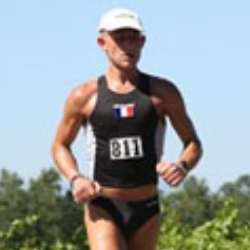
TRIATHLON RELAY RUN
The Eurotrashers relay team earned a #2 spot in their age group at Vineman in Sonoma, California on July 31, 2010. Here I will give advice about the Triathlon Relay Run!
Fabian Kremkus did a great time in the 2.4mi swim in the Russian River, Stuart McDougal delivered an efficient 112mi ride and Arno Kroner ran a marathon (26.1 mi) in 83F heat (a bit vomiting, not sure why). Good job everyone!
Surfing wetsuits, marshmallows, and speedos do get results! There have been talks of a silver medal with the engraving: “Eurotrashers Are Almost The Best”.
Now what about running in a triathlon relay team? I have done a fair amount of running in triathlon teams, individually and in the Disney Triteam. We did win some medals in relays (we might have to collect an extra medal at Vineman now!). Being a runner in the Disney team at Alcatraz I gained my first exposure to the fun of triathlon and it got me hooked to the sport.
There are two types of runs in triathlon, short course triathlon runs (Sprint, Olympic triathlons) and long course triathlon runs (ITU long distance, half iron, full iron). The issues and the strategies are different for each run category (and of course for each athlete).
Aspects that the two types of run share are timing and transition. Although the wait is shorter in sprint distances it is as important to manage the pre-run well in terms of arousal, warm-up, equipment and nutrition.
Excitement
If you get too wound up too early, the adrenaline flow is going to stop at some point if you have to wait too long. It is advisable to warm up very lightly and increase the warmup intensity when the cyclist is in sight. the rest of the time should be spent resting and eating and hydrating lightly.
Warm-up
Although the nature of warm-up workouts is specific to the distance, the timing of the warm-up is tricky. Since the runner doesn’t know when the biker will show up it is very hard to time the start of the warmup as well as its intensity. The same goes for race nutrition, when to start it and with what. How much fluid?
Nutrition
Race nutrition starts in transition no matter the race distance. It is important to start eating and drinking what will be the fuel for the race. The nutrition timing again is the aspect of relay running that becomes tricky. Once in an Olympic relay team I drank a Red Bull too early at the end of a warmup that was also too early and I ran out of the full steam ten minutes before the end of the run, the same ten minutes I started everything early.
Regarding the specifics of each run distance, I considere that depending on the athlete they follow two lines: time of day and nutrition.
Shorter Runs
They tend to run earlier in the day, possibly as early as 7:30. This helps because the body and the mind do not have to wait a long time before springing into action. The weather is typically more clement in the early morning. as a consequence, a sound nutrition strategy is easier to implement. after a regular breakfast eat snacks with protein and cards at 90 mn intervals. hydrate normally.
Longer Runs
They tend to happen in the afternoon when the wait has been long in and outside of transition and when the temperature might have climbed in the 80s or 90s. This impacts nutrition strategy and mental conditioning. Running a marathon in the afternoon requires the most different strategy. After breakfast the strategy is to follow more or less a race nutrition all day with less hydration off course. Think about what you would eat if you were on the bike for 5 to 6 hours on this day. avoid undue amounts of caffeine (avoiding caffeine completely is better, perhaps keeping the kick for late in the race when you really need it), try to take a nap and keep on drinking depending on your sweat rate. It won’t hurt to alternate water with an electrolyte drink.
When it’s time to start running, nutrition does not change. In short course you probably don’t have to eat anything and in long course you should have packed your own or checked what they served on the course if you decide to use that. In all cases, the same old wisdom applies: on race day do not do anything different than in training.
Since you probably don’t run single marathons or half-marathons in the afternoon be very careful with pacing and nutrition. As always, I recommend a negative split strategy, so start slow and build up the pace in the second half or last third. In the heat, hydration should be your main focus. Drink enough as you know yourself, take some electrolyte capsules and don’t worry too much about it (you might end up drinking too much). Anything that feels like sloshing liquid in your stomach stop drinking until it ceases.
Transition
The runner usually has the chip attached by the swimmer who takes it from the biker. Always double check it’s well fastened, it’s worth the extra seconds. And off you go. A privilege of being the runner on a tri-team is that you get to pass a lot of the athletes who did the whole thing. And you get to go through the finish line and collect the medal(s).

